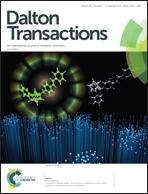Designing new iridium(iii) arene complexes of naphthoquinone derivatives as anticancer agents: a structure–activity relationship study†
Abstract
A series of iridium(III) arene complexes of naphthoquinone derivatives of the formula [IrIII(η6-L1)(L2)(3,5-(NO2)2pcyd)](PF6) (L1 = p-methylphenyl)ethynylferrocene; L2 = Lap: lapachol, 1, Plum: plumbagin, 2, Law: lawsone, 3, and Jug: juglone, 4; 3,5-(NO2)2pcyd = 3,5-dinitrophenylcyanamide) have been synthesized and investigated for their suitability as potential anticancer drugs. The DNA-binding interactions of the complexes with calf thymus DNA have been studied by absorption, emission, and viscosity measurements. Their cytotoxicity against the cancer cell lines including colon adenocarcinoma (HT-29), liver hepatocellular carcinoma (HepG-2), breast (MCF-7), colon carcinoma (HCT-8), and ovary (A2780) is reported. Remarkably, almost all complexes exhibit significant cytotoxic effects towards HepG-2, MCF-7, and HCT-8 cancer cell lines and complex 1 emerged as the most cytotoxic derivative in comparison with other complexes. The complexes 1–4 increase the production of reactive oxygen species (ROS) in MCF-7 cells. The new compounds also inhibit the enzyme thioredoxin reductase activity at nanomolar concentrations. Furthermore, the complexes induce major levels of cancer cell death by apoptosis that is in correlation with activity in cytotoxicity studies.



 Please wait while we load your content...
Please wait while we load your content...